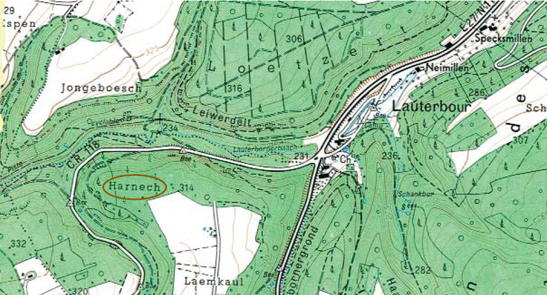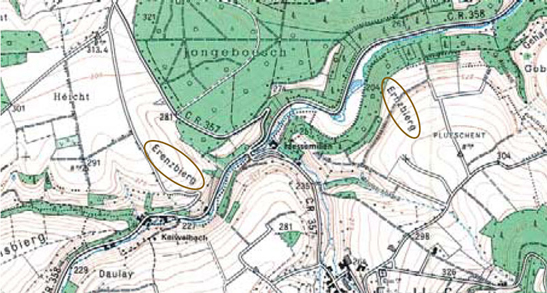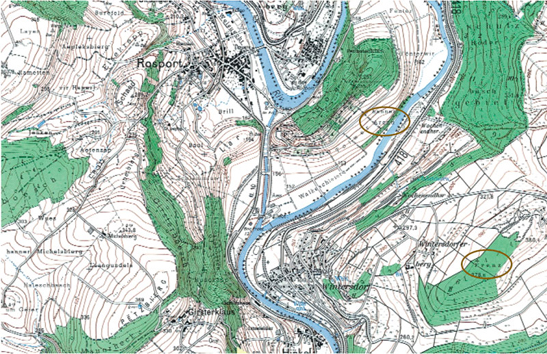Analysis of a name
Entering this pavilion, you articulate undoubtedly the question which admonished you for a long time: ”What means exactly AARNESCHT?” They will answer you that this name of place is very much special, a bit or even strange, just as climate, flora and fauna which you are going to meet there…
Our purpose, to us, will be to approach the problem of the AARNESCHT by its etymological data. We ask: Is there somewhere, in some corner of the country, another AARNESCHT identical to ours? Or is ours unique?
More than one had thought of it; until the moment when somebody reminded: Near Lauterbour, near the road of Echternach to Scheidgen a rocky and wooded crest rises. Its name: HARNECH. Striking is the similarity of both places, as for their topography as well as for their toponymy! Would there be consanguinity?

The place “Harnech” is situated near Lauterbour not far from Echternach
Certainly not. Harnisch, German form of HARNECH, is a notion of geology, and indicates some rock-forming. Now the AARNESCHT does not have any (more?) rocks!
And if we found in an old document a former orthography for our place, an orthography from long ago? Would this move us forward? In the date of 1633, we read: ”an der ARENEST”. We underline the first ” E ” intercalated between R and N. His role seems trifling, but his importance will show itself primordial.
Indeed: The phonetic groups rsp. “RN” and “REN”, as well as rsp.” RM “and ” REM” can differentiate literary language and dialect. Ex: von ferne — fu fären; gerne — gären; hindern — hënneren; arm — arem; Wurm-Wurem
It will be allowed to conclude: The scripteur of 1633, in its orthography, reproduced the name as he had heard it. Later, and according to usage at the cartographers, the primitive written form with a “literary” written form was replaced. It is in this written form AARNESCHT that today we say and write the name.
As for the meaning of AARNESCHT, we looked for her and we found her in the aquatic concept of ERNZ, leaving from ARANZIA. Received in this way: ERNZEN (white Ernz) ERNSTER (black Ernz), besides these villages of the heights as ERENZBIERG and ERNZBIERG (Ernz white), and finally the AARNESCHT their name. The initial letter, in the quoted names, “A”, “AE” or “E”, hardly seems to matter.

In Eppeldorf, we find near the White Ernz several mountains which bear the name of this river
To give to a locality the name of the watercourse, on the bank — or at least nearby — of which it is located, is quite normal. Examples: Syren, Ouren, Attert, Ernzen. Also normal will be to remind of the watercourse in the name of the locality. (see Saarbrücken, Vielsalm, Salmrohr, Kandersteg, Cambridge.)
However it seems not very logical to apply the same technique to localities and sites very distant from the watercourse “Ernz”. What is well the case of ERNZEN (ECHTERNACH), ERENZ (WINTERSDORF), ”hanner AREND” (Rosport), ARENS-BERG (EIFEL), in Hostert, where the site of the current football pitch would have probably carried the name “ERENZ” (according to the information of mister Jängy Bintener, announced by mister André Hildgen), and still of “AARNESCHT”, in our opinion. The calling, topography sees them as climaxes of a hilly crest most often wooded. What is not worth for Ernzen (east of Echternach.)

In Rosport and in Wintersdorf, who is near the Sure, places — said “Arend” and “Erenz” indicate crests of mountains-islets.
It is therefore in orographie, and not in hydrowritten form that it would be necessary to search the sense of AARNESCHT. It is true that the last gave a contribution of size: All waters of AARNESCHT head for the Syre, while no joins the very close Ernz.
A final word regarding the suffixes “-scht,-cht,-st.” They abound in our language, and their three forms are regional.
We will keep: The current way of saying and of writing AARNESCHT introduces two opposite tendencies: On one hand, she strives towards the literary language by leaving “E — parasite”. On the other one, she borrows her suffix from the dialect. This ambiguity is perhaps the reason of a stealthy impression of strangeness.
To end: Unable to interpret the name of AARNESCHT with the last rigour, we will try to define him concisely:” It indicates, slightly distorted by concessions made in languages and dialectal and literary, the crest of a mountain-islet”.
THE AARNESCHT is the prototype of a small number of mountains-islands distributed in the country. Lending to the sun the side turned in the South, they allow, in a climate, Southern almost, to the curious walker, to discover and to appreciate a flora and a fauna from other places — and to become an informed friend of the nature.
E. Steinmetzer
